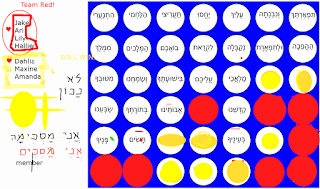When my reply ended up being rather lengthy, I figured it would do better as a separate blog post.
I teach via Zoom, and Zoom has a feature that allows you to share your screen. It is the green
which word they were reading in our Squares game. As the host, you find "Annotate" in the tool bar, which will drop down when you hover over the top of your screen (or wherever you see the green and red bar, notifying you that you are sharing your screen.) You must already be sharing your screen to see the "Annotate" option.
| Class Dojo's Portfolio, where students submit their work. |
Another option is to ask parents (or able students) to take a photo of their work with a smartphone and email the picture to you. The negative is that this can be hard to coordinate during class and often has to be done as homework.
If you don't want your students or their parents to deal with yet another technology, you can take a screenshot (a.k.a. print to screen) of your students holding their work up to the video camera. They DEFINITELY should write with dark-colored markers to make sure the letters are visible, and they need to be very steady. You will want to set your Zoom view to "speaker view" so that you see one student at a time in full screen. (Whoever is talking will show up, so you may need to mute the other students so that you aren't dealing with different students flashing on the screen while trying to take a screenshot.)
If you are unsure how to print to screen and you have a PC, watch this 45 second video: How to take a screenshot.
If you have a MAC, hold down these three keys: Shift + Command + 3
The image should save to your desktop.

